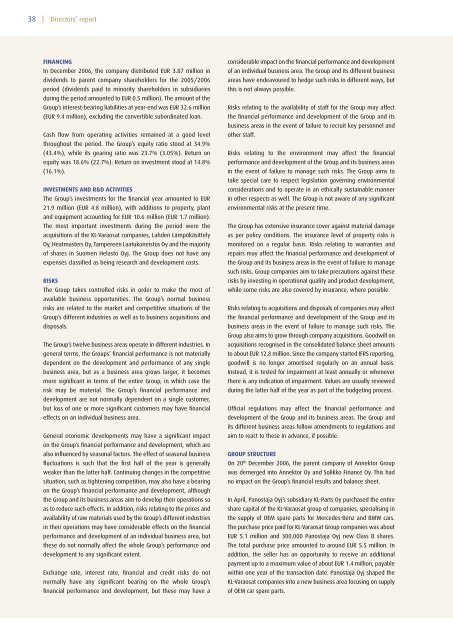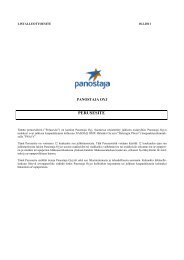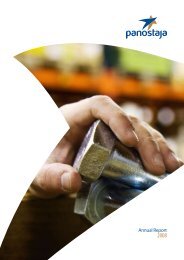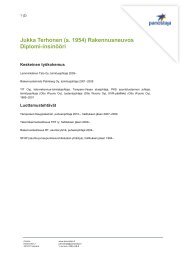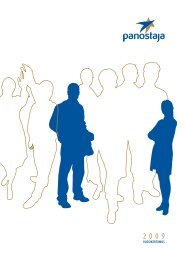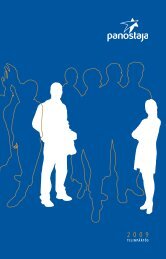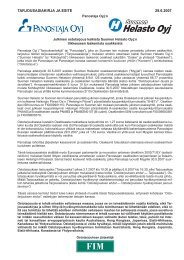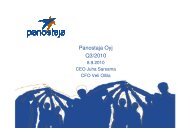Annual Report 2007 - Panostaja
Annual Report 2007 - Panostaja
Annual Report 2007 - Panostaja
You also want an ePaper? Increase the reach of your titles
YUMPU automatically turns print PDFs into web optimized ePapers that Google loves.
38 |<br />
Directors’ report<br />
FINANCING<br />
In December 2006, the company distributed EUR 3.87 million in<br />
dividends to parent company shareholders for the 2005/2006<br />
period (dividends paid to minority shareholders in subsidiaries<br />
during the period amounted to EUR 0.5 million). The amount of the<br />
Group’s interest-bearing liabilities at year-end was EUR 32.6 million<br />
(EUR 9.4 million), excluding the convertible subordinated loan.<br />
Cash flow from operating activities remained at a good level<br />
throughout the period. The Group’s equity ratio stood at 34.9%<br />
(43.4%), while its gearing ratio was 23.7% (3.05%). Return on<br />
equity was 18.6% (22.7%). Return on investment stood at 14.8%<br />
(16.1%).<br />
INVESTMENTS AND R&D ACTIVITIES<br />
The Group’s investments for the financial year amounted to EUR<br />
21.9 million (EUR 4.8 million), with additions to property, plant<br />
and equipment accounting for EUR 10.6 million (EUR 1.7 million).<br />
The most important investments during the period were the<br />
acquisitions of the KL-Varaosat companies, Lahden Lämpökäsittely<br />
Oy, Heatmasters Oy, Tampereen Laatukoneistus Oy and the majority<br />
of shares in Suomen Helasto Oyj. The Group does not have any<br />
expenses classified as being research and development costs.<br />
RISKS<br />
The Group takes controlled risks in order to make the most of<br />
available business opportunities. The Group’s normal business<br />
risks are related to the market and competitive situations of the<br />
Group’s different industries as well as to business acquisitions and<br />
disposals.<br />
The Group’s twelve business areas operate in different industries. In<br />
general terms, the Groups’ financial performance is not materially<br />
dependent on the development and performance of any single<br />
business area, but as a business area grows larger, it becomes<br />
more significant in terms of the entire Group, in which case the<br />
risk may be material. The Group’s financial performance and<br />
development are not normally dependent on a single customer,<br />
but loss of one or more significant customers may have financial<br />
effects on an individual business area.<br />
General economic developments may have a significant impact<br />
on the Group’s financial performance and development, which are<br />
also influenced by seasonal factors. The effect of seasonal business<br />
fluctuations is such that the first half of the year is generally<br />
weaker than the latter half. Continuing changes in the competitive<br />
situation, such as tightening competition, may also have a bearing<br />
on the Group’s financial performance and development, although<br />
the Group and its business areas aim to develop their operations so<br />
as to reduce such effects. In addition, risks relating to the prices and<br />
availability of raw materials used by the Group’s different industries<br />
in their operations may have considerable effects on the financial<br />
performance and development of an individual business area, but<br />
these do not normally affect the whole Group’s performance and<br />
development to any significant extent.<br />
Exchange rate, interest rate, financial and credit risks do not<br />
normally have any significant bearing on the whole Group’s<br />
financial performance and development, but these may have a<br />
considerable impact on the financial performance and development<br />
of an individual business area. The Group and its different business<br />
areas have endeavoured to hedge such risks in different ways, but<br />
this is not always possible.<br />
Risks relating to the availability of staff for the Group may affect<br />
the financial performance and development of the Group and its<br />
business areas in the event of failure to recruit key personnel and<br />
other staff.<br />
Risks relating to the environment may affect the financial<br />
performance and development of the Group and its business areas<br />
in the event of failure to manage such risks. The Group aims to<br />
take special care to respect legislation governing environmental<br />
considerations and to operate in an ethically sustainable manner<br />
in other respects as well. The Group is not aware of any significant<br />
environmental risks at the present time.<br />
The Group has extensive insurance cover against material damage<br />
as per policy conditions. The insurance level of property risks is<br />
monitored on a regular basis. Risks relating to warranties and<br />
repairs may affect the financial performance and development of<br />
the Group and its business areas in the event of failure to manage<br />
such risks. Group companies aim to take precautions against these<br />
risks by investing in operational quality and product development,<br />
while some risks are also covered by insurance, where possible.<br />
Risks relating to acquisitions and disposals of companies may affect<br />
the financial performance and development of the Group and its<br />
business areas in the event of failure to manage such risks. The<br />
Group also aims to grow through company acquisitions. Goodwill on<br />
acquisitions recognised in the consolidated balance sheet amounts<br />
to about EUR 12.8 million. Since the company started IFRS reporting,<br />
goodwill is no longer amortised regularly on an annual basis.<br />
Instead, it is tested for impairment at least annually or whenever<br />
there is any indication of impairment. Values are usually reviewed<br />
during the latter half of the year as part of the budgeting process.<br />
Official regulations may affect the financial performance and<br />
development of the Group and its business areas. The Group and<br />
its different business areas follow amendments to regulations and<br />
aim to react to these in advance, if possible.<br />
GROUP STRUCTURE<br />
On 20 th December 2006, the parent company of Annektor Group<br />
was demerged into Annektor Oy and Solikko Finance Oy. This had<br />
no impact on the Group’s financial results and balance sheet.<br />
In April, <strong>Panostaja</strong> Oyj’s subsidiary KL-Parts Oy purchased the entire<br />
share capital of the KL-Varaosat group of companies, specialising in<br />
the supply of OEM spare parts for Mercedes-Benz and BMW cars.<br />
The purchase price paid for KL-Varaosat Group companies was about<br />
EUR 5.1 million and 300,000 <strong>Panostaja</strong> Oyj new Class B shares.<br />
The total purchase price amounted to around EUR 5.5 million. In<br />
addition, the seller has an opportunity to receive an additional<br />
payment up to a maximum value of about EUR 1.4 million, payable<br />
within one year of the transaction date. <strong>Panostaja</strong> Oyj shaped the<br />
KL-Varaosat companies into a new business area focusing on supply<br />
of OEM car spare parts.


